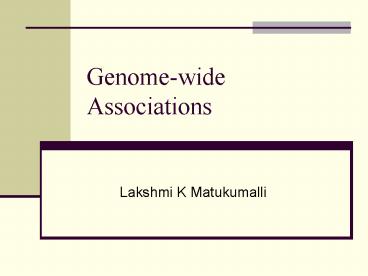Genomewide Associations - PowerPoint PPT Presentation
Title:
Genomewide Associations
Description:
Where genes are mapped by typing genetic markers in families ... Age-Related Macular Degeneration. Complement Factor H Polymorphism. Samples. 1,464 Patients T2D ... – PowerPoint PPT presentation
Number of Views:57
Avg rating:3.0/5.0
Title: Genomewide Associations
1
Genome-wide Associations
- Lakshmi K Matukumalli
2
Illumina SNP Genotyping
Chemistry
Genotype Data
3
Fine Mapping with SNP Markers
- Advantages of SNPs as genetic markers
- as compared to microsatellites.
- High abundance
- Distribution throughout the genome
- Ease of genotyping
- Improved accuracy
- Availability of high throughput
- multiplex genotyping platforms
4
Objectives for GWA
- Create Cures for Diseases (Humans)
- Localize diseases to narrow chromosomal regions
- Identify causative mutations for disease
- Genetic predisposition to drugs / diseases
- Personalized medicine
- Selection Decisions (Live stock Plants)
- Increased productivity, disease resistance,
composition (Fat, protein, tenderness) - Identification of QTL regions
- Application of Marker assisted selection
- Genome Selection
5
Traditional Methods
QTL
LINKAGE MAPPING Where genes are mapped by typing
genetic markers in families to identify regions
that are associated with disease or trait values
within pedigrees more often than are expected by
chance. Such linked regions are more likely to
contain a causal genetic variant. ADMIXTURE
MAPPING Predicting the recent ancestry of
chromosomal segments across the genome to
identify regions for which recent ancestry in a
particular population correlates with disease or
trait values. Such regions are more likely to
contain causal variants that are more common in
the ancestral population. PENETRANCE The
proportion of individuals with a specific
genotype who manifest the genotype at the
phenotypic level. For example, if all individuals
with a specific disease genotype show the disease
phenotype, then the genotype is said to be
'completely penetrant'. HERITABILITY The
proportion of the variation in a given
characteristic or state that can be attributed to
(additive) genetic factors.
Emergence of Variations Over Time
Common Ancestor
time
present
6
Linkage Mapping
Non-Parametric Linkage
Transmission Disequilibrium Test (TDT)
7
Genome Wide Association
- Principles
- Fishers theory of additive effects of common
alleles - Human heterozygosity is attributed to common
ancestral variants - (CDCV Common disease common variant
hypothesis) - Variants influencing common late onset
diseases of modernity may not have been subject
to purifying selection
8
(No Transcript)
9
Whole Genome Prediction
- Fit haplotype block into a statistical model
Effect
A
B
C
D
E
F
G
H
I
J
K
L
M
1
1
1
1
1
1
1
1
1
1
1
1
1
1
Levels
2
2
2
2
2
2
2
2
2
2
2
2
2
2
3
3
3
3
3
3
3
3
3
3
4
4
4
4
10
Genome Enhanced PBV
11
Genome Wide Association - Methods
- Gene centric approach
- Non-ascertained (Uniformly spaced / Tag SNPs)
12
(No Transcript)
13
Age-Related Macular Degeneration
Complement Factor H Polymorphism
14
Samples 1,464 Patients T2D 1,464 Case Controls
Traits Glucose metabolism Lipids Obesity Blood
pressure
Follow-up 107 SNPs on extreme p-values genotyped
on 10, 850 additional populations
15
Type 2 diabetes and triglyceride levels
- T2D
- non-coding region near CDKN2A and CDKN2B
- Intron of IGF2BP2
- Intron of CDKAL1
- Triglycerides
- Intron of glucokinase regulatory protein
16
Coronary Heart Disease
375,00 SNPs WTCCC 1926 Case 2938 Controls German
GI Family 875 Case 1644 Control Genotyping by
candidate gene approach
17
Significant Associations 9p21.3 region P1.80 x
10(-14) WTCCC P3.40 x 10(-6), German MI Family.
The WTCCC study revealed nine loci that were
strongly associated with coronary artery disease
(Plt1.2 x 10(-5)) and less than a 50 chance of
being falsely positive). Two additional loci at
6q25.1 and 2q36.3 were also successfully
replicated in the German study The combined
analysis of the two studies identified four
additional loci significantly associated with
coronary artery disease (Plt1.3 x 10(-6))) and a
high probability (gt80) of a true association
chromosomes 1p13.3, 1q41, 10q11.21, and 15q22.33.
18
GWA of seven Common Diseases 14,000 Cases
(2,000 each) 3,000 shared controls
19
Determining Marker Order
Clones
Chromosome segments
Genotyping
A BC D E F G
20
- Neutral Evolution
- Versus
- Positive Natural Selection
- http//ai.stanford.edu/serafim/CS374_2006/present
ations/lecture5.ppt































